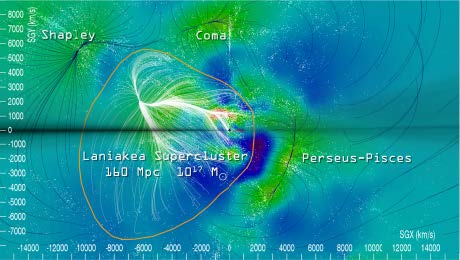Max Stritzinger, IFA had an idea!
The Villum Experiment Grants seek to reward scientists who question conventional thinking, and thus the idea of building up a cosmography of Laniakea via the distribution of Type Ia supernovae, the peculiar velocities of their host galaxies and Dark Matter distribution has been awarded a grant of DKK 1 993 738,00.

The proposal was submitted anonymously like 400 others, and it goes like this: We propose to observe 50 Type Ia supernovae to demonstrate the ability to obtain systematic limited (better than 3%) distances with minimal observing resources. The outcome of this pilot project will include a measurement of the local Hubble constant and the detection of the peculiar velocities of the supernova host galaxies caused by the large scale distribution of dark matter.

Laniakea - our nearest neighbourhood in the Universe. Illustration from the application.
This will enable us to quantify the requirements for a full scale project to measure peculiar velocities from a sample of supernovae that would be 100 times larger. The aim of this research is to identify the distribution in space of the major dark matter concentration driving our peculiar motion relative to that of the linear Hubble expansion. Ultimately, our work will reveal an expanded understanding of how dark matter clusters on small scales, and in doing so will also provide fundamental constraints for modern structure formation simulations.
Science director Thomas Bjørnholm of the Villum Fondations says: “The bold idea that you might not dare to mention aloud may challenge acclaimed research even though it doesn’t fit into the conventional peer-review funding system.”
The press release from the Villum Foundations concerning all 52 recipients is here.
